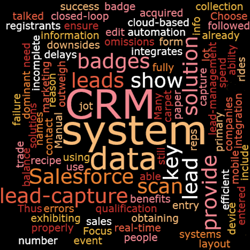|
REGISTRATION REQUIRED
exhibiting 101
 The Full Report
Share your trade show program's value-proving metrics with management by crafting a post-show report that includes these 10 elements.
While the Great Recession may be in the rearview mirror, most exhibit managers still lack peace of mind when it comes to the preservation of their trade show programs. More than ever, trade show professionals are expected to prove their programs' return on investment. And the most effective way to demonstrate ROI is providing executives with a comprehensive post-show report.
But what do upper management and your program's stakeholders want from your show report? More often than not, they're looking for data in four key areas: strategy, results, budget, and plans for improvement. Along those lines, here are 10 sections to include in your report that will address each of these points, help prove your program's worth, and potentially protect your budget. 1. Executive Summary The first section of your post-show report should serve as a 30,000-foot overview of the whole show. After all, this one-page brief may be the only part of your report many executives read. The executive summary should include five succinct sections: your strategic goals and objectives for the show; the most critical results, such as your overall lead count, quality of leads, press interviews, number of branding impressions, number of prospects exposed to new product(s), etc.; a summary of the exhibit and accompanying activities; a budget summary; and any future goals and recommendations. 2. Strategic Goals and Objectives Start by providing the big picture: how your exhibit supports corporate goals and initiatives. Then, list each of your exhibit's pre-show objectives and evaluate whether you achieved them. Analyze any goals and objectives you did not meet and state how you will reach them in the future, or revise them to make them more relevant. If you're doing a show-to-show or year-to-year comparison, make sure you're comparing consistent information. 3. Sales-Lead Report Most companies' primary reason for exhibiting is to gather sales leads, so the quantity and quality of the leads gathered is of prime importance to your executives and stakeholders. First identify the total number of leads; then break that down into a qualitative assessment. Categorize the leads as A, B, or C leads, based on the type of prospect (individual buyer, dealer or distributor, or past client), decision-making power, need for and interest in your product, time frame to buy, budget, and desire for follow-up after the show. Clearly define your evaluating criteria for each lead category and your follow-up process. Finally, include the hard numbers related to the bottom line. Calculate the cost per lead by dividing the direct costs of your trade show participation by the number of qualified leads. Talk with sales management to determine an estimated closing ratio of the leads, the potential average value of each sale, and a projected time period to close them. Then include that information in your show report to give a more global view of the value of those qualified leads. 4. Press/Media Results Identify the number of media reps that visited the booth, attended your event, and/or met with your press liaison or executive management. Count the number of interactions that resulted in favorable press mentions within a specific time period. If available, include positive excerpts from the coverage. If you do not already have an established method for quantifying the value of press mentions, contact each publication to find out what you'd have to pay for an ad of comparable size. (For example, if the magazine published a half-page story on your new product, how much would a half-page ad cost?) According to the Public Relations Society of America, media coverage is more than twice as credible and conveys a higher influence on consumers than paid advertising. So multiply that cost by 2.5 to address the credibility factor of nonadvertisement coverage and include that figure in your report as the total value of the press coverage generated at the show. 5. Exhibit Effectiveness Include a brief description and evaluation of your exhibit, including any available photographs or renderings and a statement on each of the following components: ➤ Exhibit properties. Was the design functional to reach your objectives, and was the condition of your exhibit properties consistent with the image your company wants to portray? ➤ Product displays. What products did you feature, and how were they displayed? Could visitors identify your separate products or product lines from a distance? How did visitors engage with the products? ➤ Graphics. Did your graphics draw attendees into your booth? Were your messages clear and compelling? ➤ Booth location, layout, and traffic flow. How did the location of the exhibit affect traffic flow? Did the size and layout of your exhibit invite visitors to enter and remain long enough to engage with your staff? 6. Promotions and Exhibit Activities Review the effectiveness of each of your pre-show, at-show, and post-show promotional programs and sponsorships. This analysis can be both objective, such as measuring the number of attendees who returned a pre-show mailer to your exhibit in exchange for a gift, and subjective, such as feedback from press who attended your media event. Report on any ancillary events, such as hospitality suites, customer thank-you dinners, co-sponsored events with partners, customer or dealer/distributor training, sponsored conference sessions, or participation by company employees or key clients in conference seminars. 7. Booth Staff Evaluate the effectiveness of your booth staff and analyze the following details: ➤ Number of staff members. Did you have enough or too many staff members working during setup and teardown and during show hours? ➤ Pre-show training. Review your exhibit staff's pre-show training in the following areas: strategy, product, boothmanship, and logistics. Was the training effective in enhancing your staff's understanding of show goals and in-booth behavior? If not, what changes need to be made? ➤ Staff performance. Evaluate the productivity and effectiveness of your staff, being sure to mention your most competent members by name. Record problems with your staff, such as low productivity, tardiness or absences, or incidents with customers. 8. Competitive Analysis Include a brief summary about how your company stacked up against the competition. If you assigned exhibit staff to report on competitors' show activities, develop a comprehensive analysis of your key competitors' products, exhibits, press kits, and events based on their feedback, and attach it to the report. 9. Total Show Budget Provide a comparison of your estimated budget to your final investment in the trade show. Point out everything you did to cut costs along the way. If you went over budget, explain the charges and what caused them to come in higher than projected, along with ideas for how to prevent such overruns in the future. 10. Conclusion This section should put the show into context in your overall trade show program, considering both the past and the future. If applicable, provide a year-over-year comparison of results from the same show. Indicate how this year's show was stronger or weaker, and why. Rank the show among other shows at which you exhibit based on ROI and overall impact on corporate objectives. Discuss what you want to continue doing and what you hope to improve for future shows to advance your exhibit program. And even though it's much easier to highlight your successes at a show, don't be afraid to point out your program's shortcomings as well. In all likelihood, the management team will identify them anyway. But by proactively ‐ and transparently ‐ pointing them out, you demonstrate an awareness of problem areas and can take the opportunity to comment on your plans to address them in the future.
E
 Candy Adams
Candy AdamsCTSM, CEM, CMP, CMM "The Booth Mom," is an independent exhibit project manager, trainer, speaker, consultant, and an Exhibitor Conference faculty member. CandyAdams@BoothMom.com
|
|
|
||||||||||||||||||||||||||||
|
|
||||||||||||||||||||||||||||
|
TOPICS Measurement & Budgeting Planning & Execution Marketing & Promotion Events & Venues Personal & Career Exhibits & Experiences International Exhibiting Resources for Rookies Research & Resources |
MAGAZINE Subscribe Today! Renew Subscription Update Address Digital Downloads Newsletters Advertise |
FIND IT Exhibit Producers Products & Services All Companies Get Listed |
EXHIBITORLIVE Sessions Exhibit Hall Exhibit at the Show Registration |
ETRAK Sessions Certification F.A.Q. Registration |
EDUCATION WEEK Overview Sessions Hotel Registration |
CERTIFICATION The Program Steps to Certification Faculty and Staff Enroll in CTSM Submit Quiz Answers My CTSM |
AWARDS Exhibit Design Awards Portable/Modular Awards Corporate Event Awards Centers of Excellence |
NEWS Associations/Press Awards Company News International New Products People Shows & Events Venues & Destinations EXHIBITOR News |
||||||||||||||||||||
|
||||||||||||||||||||||||||||






